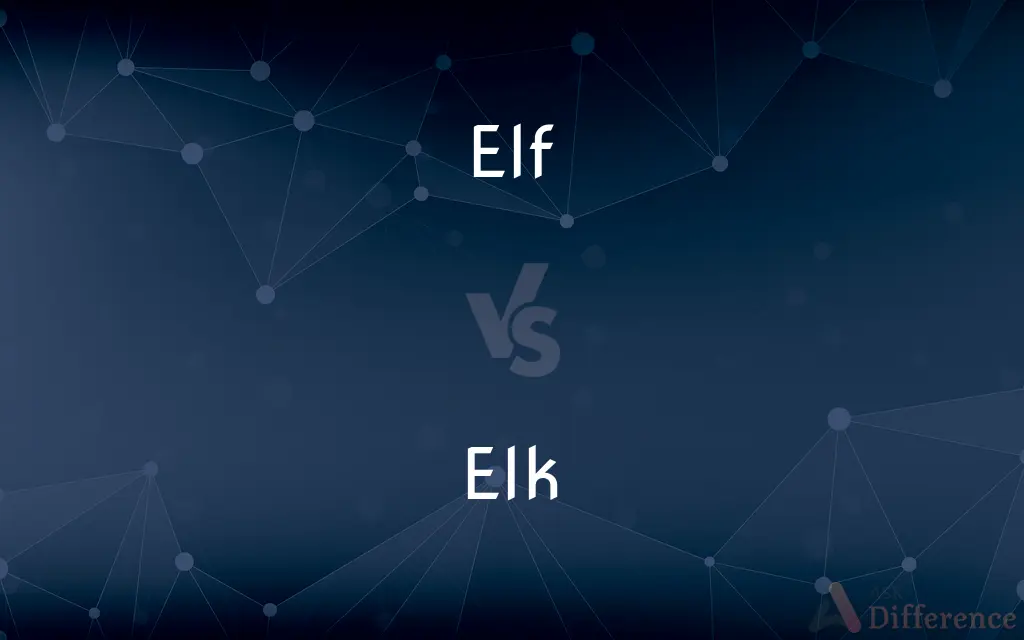Elf vs. Elk — What's the Difference?
Edited by Tayyaba Rehman — By Fiza Rafique — Updated on March 30, 2024
An elf is a mythical creature often depicted in folklore and fantasy literature as a pointy-eared, magical being, whereas an elk is a large, real-world deer species known for its impressive antlers and found in North America and parts of Eurasia.

Difference Between Elf and Elk
Table of Contents
ADVERTISEMENT
Key Differences
Elves are mythical beings from folklore and modern fantasy, characterized by their supernatural abilities, ethereal beauty, and often long lifespans. They are commonly portrayed living in forests or other natural settings, closely tied to nature and magic. Elk, on the other hand, are large mammals belonging to the deer family. Known for their massive antlers, which can span up to four feet across, elks are a symbol of strength and agility in the animal kingdom. They inhabit forested areas and are known for their rutting season, where males emit distinctive calls and compete for mates.
While elves are a creation of myth and imagination, often playing significant roles in literature, art, and games, elks are subjects of biological and ecological study, playing a crucial role in their ecosystems. The conservation of elk populations is important for maintaining biodiversity and ecological balance.
Elves and elks share only a similarity in name and occupy completely different realms of understanding—one rooted in the natural world and the other in the cultural sphere. The fascination with elves reflects humanity's love for storytelling and the supernatural, while interest in elks showcases our connection to and interest in the natural world.
Despite their stark differences, both elves and elks have captivated human interest, albeit in vastly different ways. Elves enrich our cultural narratives with tales of magic and mystery, while elks contribute to the richness of wildlife and remind us of the importance of ecological conservation and respect for nature.
Comparison Chart
Nature
Mythical being
Real-world animal
ADVERTISEMENT
Characteristics
Supernatural abilities, pointed ears
Large antlers, impressive size
Habitat
Forests, mythical realms
Forested areas, North America, and Eurasia
Role
Featured in folklore and fantasy
Part of ecosystems, studied for conservation
Significance
Cultural narratives, imagination
Biodiversity, ecological balance
Compare with Definitions
Elf
A mythical creature known for magic and mischief.
The elf used his powers to protect the forest.
Elk
A large species of deer known for its massive antlers.
The majestic elk bugled to assert its dominance.
Elf
Associated with nature and supernatural elements.
According to legend, elves could communicate with animals.
Elk
Plays an important role in its ecosystem.
Elks are key to maintaining healthy forest and grassland environments.
Elf
Plays a key role in folklore and fantasy genres.
The elves allied with humans to fight the dark forces.
Elk
Subject of wildlife conservation efforts.
Conservation programs aim to preserve elk habitats and populations.
Elf
Often depicted with pointed ears and slender figures.
Elves in the story were skilled archers and lived for centuries.
Elk
Known for their distinctive mating calls.
During the rut, the elk’s bugle can be heard across the valley.
Elf
Symbolizes wisdom and enchantment in stories.
The wise elf taught the hero the secrets of the ancient magic.
Elk
Found in North America and parts of Eurasia.
Elk populations in the Rocky Mountains are monitored for conservation.
Elf
An elf (plural: elves) is a type of humanoid supernatural being in Germanic mythology and folklore (especially North Germanic mythology and folklore). In medieval Germanic-speaking cultures, elves generally seem to have been thought of as beings with magical powers and supernatural beauty, ambivalent towards everyday people and capable of either helping or hindering them.
Elk
The elk (Cervus canadensis), also known as the wapiti, is one of the largest species within the deer family, Cervidae, and one of the largest terrestrial mammals in North America, as well as Central and East Asia. It is often confused with the larger Alces alces, which is called moose in North America, but called elk in British English, and related names in other European languages (German Elch, Swedish älg, French élan).
Elf
A mythical creature in human form but usually smaller, often considered mischievous.
Elk
A large reddish-brown or grayish deer (Cervus canadensis) of western North America, having long, branching antlers in the male. The elk is sometimes considered a subspecies of the closely related red deer. Also called wapiti.
Elf
A lively, mischievous child.
Elk
Chiefly British The moose.
Elf
A usually sprightly or mischievous or sometimes spiteful person.
Elk
A light, pliant leather of horsehide or calfskin, tanned and finished to resemble elk hide.
Elf
(Norse mythology) A luminous spirit presiding over nature and fertility and dwelling in the world of Álfheim (Elfland). Compare angel, nymph, fairy.
Elk
Any of various large species of deer such as the red deer, moose or wapiti (see usage notes).
Elf
Any from a race of mythical, supernatural beings resembling but seen as distinct from human beings. They are usually delicate-featured and skilled in magic or spellcrafting; sometimes depicted as clashing with dwarves, especially in modern fantasy literature.
Elk
Any of the subspecies of the moose (Alces alces, alternatively named Eurasian elk to avoid confusion with the wapiti), that occurs only in Europe and Asia.
Elf
(fantasy) Any of the magical, typically forest-guarding races bearing some similarities to the Norse álfar (through Tolkien's Eldar).
Elk
Any moose (Alces alces), the largest member of the deer family.
Elf
A very diminutive person; a dwarf.
Elk
(North America) common wapiti (Cervus canadensis), the second largest member of the deer family, once thought to be a subspecies of red deer.
Elf
(South Africa) The bluefish (Pomatomus saltatrix).
Elk
(British India) Sambar (Cervus unicolor).
Elf
To twist into elflocks (of hair); to mat.
Elk
A large deer, of several species. The European elk Alces alces (formerly Alces machlis or Cervus alces) is closely allied to the American moose. The American elk, or wapiti (Cervus Canadensis) the largest member of the deer family, has large, spreading antlers and is closely related to the European stag. See Moose, and Wapiti.
Elf
An imaginary supernatural being, commonly a little sprite, much like a fairy; a mythological diminutive spirit, supposed to haunt hills and wild places, and generally represented as delighting in mischievous tricks.
Every elf, and fairy sprite,Hop as light as bird from brier.
Elk
The European wild or whistling swan (Cygnus ferus).
Elf
A very diminutive person; a dwarf.
Elk
A member of the fraternal organization named Benevolent and Protective Order of Elks, supporting various services to their communities.
Elf
To entangle mischievously, as an elf might do.
Elf all my hair in knots.
Elk
Large northern deer with enormous flattened antlers in the male; called elk in Europe and moose in North America
Elf
(folklore) fairies that are somewhat mischievous
Elf
Below 3 kilohertz
Common Curiosities
What do elk eat?
Elk are herbivores, feeding on grasses, plants, leaves, and bark.
Can elves be found in all cultures?
While many cultures have similar concepts of magical beings, elves specifically originate from Norse mythology and have been popularized by Western literature and media.
Are elves real creatures?
Elves are mythical beings from folklore and fantasy, not real entities.
What is the significance of elk in indigenous cultures?
For many indigenous peoples, elk hold cultural significance and are respected for their strength, agility, and as a source of sustenance.
Do elves have any weaknesses?
In various stories, elves may have specific weaknesses tied to their magical nature, but these vary widely depending on the folklore or fantasy setting.
Are there different types of elk?
Yes, there are several subspecies of elk, including the Rocky Mountain elk, Roosevelt elk, and others, with variations in size and habitat.
How have elves influenced modern culture?
Elves have had a significant impact on modern culture, influencing literature, movies, video games, and holiday traditions (e.g., Christmas elves).
How large can elk antlers get?
Elk antlers can grow up to four feet across and are shed and regrown annually.
What conservation efforts are in place for elk?
Conservation efforts for elk include habitat preservation, management of hunting to ensure healthy populations, and research into their ecological impact.
Can elk be domesticated?
While elk can be kept in controlled environments for farming or conservation, they are not domesticated in the same way as dogs or cats.
How do elk adapt to their environment?
Elk adapt through migration, diet variation, and social behavior to survive in various climates and ecosystems.
How are elves depicted in different media?
Elves are portrayed in diverse ways, from the noble warriors of high fantasy to the playful helpers of Santa Claus, reflecting their versatility in human imagination.
How do elves and elk compare in terms of social structure?
Elves are often depicted with complex social structures and kingdoms in fantasy literature, while elks have real-world social structures based on herds and seasonal mating hierarchies.
What role do elves play in folklore?
In folklore, elves are often seen as protectors of nature, tricksters, or beings with a deep connection to the magical world.
What are the challenges facing elk conservation?
Challenges include habitat loss, climate change, and conflicts with human activities such as agriculture and development.
Share Your Discovery

Previous Comparison
Eskimo vs. Aleut
Next Comparison
Oxycodone vs. HydrocodoneAuthor Spotlight
Written by
Fiza RafiqueFiza Rafique is a skilled content writer at AskDifference.com, where she meticulously refines and enhances written pieces. Drawing from her vast editorial expertise, Fiza ensures clarity, accuracy, and precision in every article. Passionate about language, she continually seeks to elevate the quality of content for readers worldwide.
Edited by
Tayyaba RehmanTayyaba Rehman is a distinguished writer, currently serving as a primary contributor to askdifference.com. As a researcher in semantics and etymology, Tayyaba's passion for the complexity of languages and their distinctions has found a perfect home on the platform. Tayyaba delves into the intricacies of language, distinguishing between commonly confused words and phrases, thereby providing clarity for readers worldwide.
















































